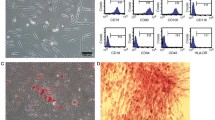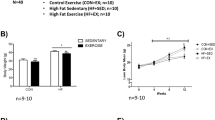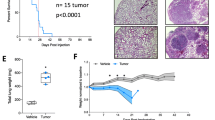Abstract
Purpose
Although the mechanism of onset and progression of radiation-induced fibrosis (RIF) has been studied, most studies to date have focused on pulmonary fibrosis. There are few studies on murine RIF in the skeletal muscle, and the pathogenic mechanism remains unclear. This pilot study aimed to evaluate the feasibility to create a murine model of RIF in the skeletal muscle and analyze strain differences in fibrosis sensitivity.
Materials and methods
Two mouse strains, C57BL/6 and C3H/He, were used. Their right hind limbs were irradiated at a dose of 25 Gy once a week for three fractions. Gastrocnemius muscles were collected at day 4, and weeks 2, 4, 8, 12, and 24 after the third irradiation and subjected to histopathological examination and immunoblotting.
Results
In C57BL/6 mice, chronic inflammation and an increased expression of transforming growth factor-β (TGF-β) and fibronectin were observed 2 weeks after irradiation. A significant increase in fibrosis was detected after 8 weeks. However, in C3H/He mice, the expression of TGF-β and fibronectin increased 8 weeks after irradiation, and fibrosis significantly increased after 12 weeks. Moreover, the degrees of inflammation and fibrosis were more remarkable in C57BL/6 mice than in C3H/He mice.
Conclusion
The onset and degree of fibrosis may be associated with the expression of TGF-β and fibronectin, and inflammation, in a strain-specific manner. Therefore, a murine model of RIF in the skeletal muscle could be created using the indicated method, suggesting that the C57BL/6 strain is more sensitive to fibrosis in the skeletal muscle, as well as the lung, than the C3H/He strain.
Secondary abstract
Radiation-induced fibrosis in the skeletal muscle could be detected in C57BL/6 and C3H/He mice, with C57BL/6 mice being more sensitive to fibrosis in the skeletal muscle than C3H/He mice.







Similar content being viewed by others
References
Bentzen SM. Preventing or reducing late side effects of radiation therapy: radiobiology meets molecular pathology. Nat Rev Cancer. 2006;6:702–13.
Zeman EM. The biological basis of radiation oncology. In: Gunderson LL, Tepper JE, editors. Clinical radiation oncology. 4th ed. Philadelphia: Elsevier Inc.; 2016. p. 2–40.
Bentzen SM, Thames HD, Overgaard M. Latent-time estimation for late cutaneous and subcutaneous radiation reactions in a single-follow-up clinical study. Radiother Oncol. 1989;15:267–74.
Coomer A, Farese J, Milner R, Liptak J, Bacon N, Lurie D. Radiation therapy for canine appendicular osteosarcoma. Vet Comp Oncol. 2009;7:15–27.
Milano MT, Marks LB, Constine LS. Late effects after radiation. In: Gunderson LL, Tepper JE, editors. Clinical radiation oncology. 4th ed. Philadelphia: Elsevier Inc.; 2016. p. 253–74.
Vallée A, Lecarpentier Y, Guillevin R, Vallée JN. Interactions between TGF-β1, canonical WNT/β-catenin pathway and PPAR γ in radiation-induced fibrosis. Oncotarget. 2017;8:90579–604.
Stubblefield MD. Clinical evaluation and management of radiation fibrosis syndrome. Phys Med Rehabil Clin N Am. 2017;28:89–100.
Wang B, Wei J, Meng L, Wang H, Qu C, Chen X, et al. Advances in pathogenic mechanisms and management of radiation-induced fibrosis. Biomed Pharmacother. 2020;121:109560.
Gallet P, Phulpin B, Merlin JL, Leroux A, Bravetti P, Mecellem H, et al. Long-term alterations of cytokines and growth factors expression in irradiated tissues and relation with histological severity scoring. PLoS ONE. 2011;6:e29399.
Rubin P, Johnston CJ, Williams JP, Mcdonald S, Finkelstein JN. A perpetual cascade of cytokines postirradiation leads to pulmonary fibrosis. Int J Radiat Oncol Biol Phys. 1995;33:99–109.
Barnes JL, Gorin Y. Myofibroblast differentiation during fibrosis: role of NAD(P) H oxidases. Kidney Int. 2011;79:944–56.
Richter K, Kietzmann T. Reactive oxygen species and fibrosis: further evidence of a significant liaison. Cell Tissue Res. 2016;365:591–605.
Ismaeel A, Kim JS, Kirk JS, Smith RS, Bohannon WT, Koutakis P. Role of transforming growth factor-β in skeletal muscle fibrosis: a review. Int J Mol Sci. 2019;20:2446.
Chithra P, Sajithlal GB, Chandrakasan G. Influence of Aloe vera on the glycosaminoglycans in the matrix of healing dermal wounds in rats. J Ethnopharmacol. 1998;59:179–86.
Orphanides C, Fine LG, Norman JT. Hypoxia stimulates proximal tubular cell matrix production via a TGF-β1-independent mechanism. Kidney Int. 1997;52:637–47.
Vujaskovic Z, Anscher MS, Feng QF, Rabbani ZN, Amin K, Sanulski T, et al. Radiation-induced hypoxia may perpetuate late normal tissue injury. Int J Radiat Oncol Biol Phys. 2001;50:851–5.
Paris F, Fuks Z, Kang A, Capodieci P, Juan G, Ehleiter D, et al. Endothelial apoptosis as the primary lesion initiating intestinal radiation damage in mice. Science. 2001;293:293–7.
Valle-Tenney R, Rebolledo D, Acuña MJ, Brandan E. HIF-hypoxia signaling in skeletal muscle physiology and fibrosis. J Cell Commun Signal. 2020;14:147–58.
Valle-Tenney R, Rebolledo DL, Lipson KE, Brandan E. Role of hypoxia in skeletal muscle fibrosis: synergism between hypoxia and TGF-beta signaling upregulates CCN2/CTGF expression specifically in muscle fibers. Matrix Biol. 2020;87:48–65.
Haroon ZA, Raleigh JA, Greenberg CS, Dewhirst MW. Early wound healing exhibits cytokine surge without evidence of hypoxia. Ann Surg. 2000;231:137–47.
Higgins DF, Kimura K, Bernhardt WM, Shrimanker N, Akai Y, Hohenstein B, et al. Hypoxia promotes fibrogenesis in vivo via HIF-1 stimulation of epithelial-to-mesenchymal transition. J Clin Invest. 2007;117:3810–20.
Kimura K, Iwano M, Higgins DF, Yamaguchi Y, Nakatani K, Harada K, et al. Stable expression of HIF-1alpha in tubular epithelial cells promotes interstitial fibrosis. Am J Physiol Ren Physiol. 2008;295:F1023–9.
Zavadil J, Böttinger EP. TGF-beta and epithelial-to-mesenchymal transitions. Oncogene. 2005;24:5764–74.
Okada H, Danoff TM, Kalluri R, Neilson EG. Early role of Fsp1 in epithelial-mesenchymal transformation. Am J Physiol. 1997;273:F563–74.
Johnston CJ, Williams JP, Okunieff P, Finkelstein JN. Radiation-induced pulmonary fibrosis: examination of chemokine and chemokine receptor families. Radiat Res. 2002;157:256–65.
Franko AJ, Sharplin J, Ward WF, Hinz JM. The genetic basis of strain-dependent differences in the early phase of radiation injury in mouse lung. Radiat Res. 1991;126:349–56.
Kalash R, Berhane H, Au J, Rhieu BH, Epperly MW, Goff J, et al. Differences in irradiated lung gene transcription between fibrosis-prone C57BL/6NHsd and fibrosis-resistant C3H/HeNHsd mice. In Vivo. 2014;28:147–71.
Johnston CJ, Piedboeuf B, Baggs R, Rubin P, Finkelstein JN. Differences in correlation of mRNA gene expression in mice sensitive and resistant to radiation-induced pulmonary fibrosis. Radiat Res. 1995;142:197–203.
Iwakawa M, Noda S, Ohta T, Ohira C, Lee R, Goto M, et al. Different radiation susceptibility among five strains of mice detected by a skin reaction. J Radiat Res. 2003;44:7–13.
Bianchi M, Delic JI, Hurtado-de-Catalfo G, Hendry JH. Strain differences in the radiosensitivity of mouse spermatogonia. Int J Radiat Biol Relat Stud Phys Chem Med. 1985;48:579–88.
Schindelin J, Arganda-Carreras I, Frise E, Kaynig V, Longair M, Pietzsch T, et al. Fiji: an open-source platform for biological-image analysis. Nat Methods. 2012;9:676–82.
Kanda Y. Investigation of the freely available easy-to-use software ‘EZR’ for medical statistics. Bone Marrow Transp. 2013;48:452–8.
Zhou Y, Sheng X, Deng F, Wang H, Shen L, Zeng Y, et al. Radiation-induced muscle fibrosis rat model: establishment and valuation. Radiat Oncol. 2018;13:160.
Sun W, Ni X, Sun S, Cai L, Yu J, Wang J, et al. Adipose-derived stem cells alleviate radiation-induced muscular fibrosis by suppressing the expression of TGF-β1. Stem Cells Int. 2016;2016:5638204.
Dimitrievich GS, Fischer-Dzoga K, Griem ML. Radiosensitivity of vascular tissue. I. Differential radiosensitivity of capillaries: a quantitative in vivo study. Radiat Res. 1984;99:511–35.
Judge JL, Lacy SH, Ku WY, Owens KM, Hernady E, Thatcher TH, et al. The lactate dehydrogenase inhibitor gossypol inhibits radiation-induced pulmonary fibrosis. Radiat Res. 2017;188:35–43.
Rabbani ZN, Mi J, Zhang Y, Delong M, Jackson IL, Fleckenstein K, et al. Hypoxia inducible factor 1α signaling in fractionated radiation-induced lung injury: role of oxidative stress and tissue hypoxia. Radiat Res. 2010;173:165–74.
Gauter-Fleckenstein B, Fleckenstein K, Owzar K, Jiang C, Rebouças JS, Batinic-Haberle I, et al. Early and late administration of MnTE-2-PyP5+ in mitigation and treatment of radiation-induced lung damage. Free Radic Biol Med. 2010;48:1034–43.
Drouin G, Couture V, Lauzon MA, Balg F, Faucheux N, Grenier G. Muscle injury-induced hypoxia alters the proliferation and differentiation potentials of muscle resident stromal cells. Skelet Muscle. 2019;9:18.
Mann CJ, Perdiguero E, Kharraz Y, Aguilar S, Pessina P, Serrano AL, et al. Aberrant repair and fibrosis development in skeletal muscle. Skelet Muscle. 2011;1:21.
Bersini S, Gilardi M, Mora M, Krol S, Arrigoni C, Candrian C, et al. Tackling muscle fibrosis: from molecular mechanisms to next generation engineered models to predict drug delivery. Adv Drug Deliv Rev. 2018;129:64–77.
Rube CE, Uthe D, Schmid KW, Richter KD, Wessel J, Schuck A, et al. Dose-dependent induction of transforming growth factor beta (TGF-beta) in the lung tissue of fibrosis-prone mice after thoracic irradiation. Int J Radiat Oncol Biol Phys. 2000;47:1033–42.
Mahdy MAA. Skeletal muscle fibrosis: an overview. Cell Tissue Res. 2019;375:575–88.
Huard J, Li Y, Fu FH. Muscle injuries and repair: current trends in research. J Bone Joint Surg. 2002;84:822–32.
Funding
None declared.
Author information
Authors and Affiliations
Contributions
Conceptualization: TM and RI; methodology: YM, RY and RI; formal analysis and investigation: YM, RY and RI; writing—original draft preparation: YM; writing—review and editing: TM and RI; resources: TM and RI; supervision: RI.
Corresponding author
Ethics declarations
Conflict of interest
The authors declare that they have no conflicts of interest.
Ethical statement
All experiments were approved by the Gifu University Animal Experiment Committee and performed in accordance with the institutional and national guidelines for the care and use of laboratory animals.
Additional information
Publisher's Note
Springer Nature remains neutral with regard to jurisdictional claims in published maps and institutional affiliations.
About this article
Cite this article
Murakoshi, Y., Yoshikawa, R., Mori, T. et al. Feasibility study for inducing the skeletal muscle fibrosis via irradiation using two mouse strains. Jpn J Radiol 40, 466–475 (2022). https://doi.org/10.1007/s11604-021-01219-0
Received:
Accepted:
Published:
Issue Date:
DOI: https://doi.org/10.1007/s11604-021-01219-0




